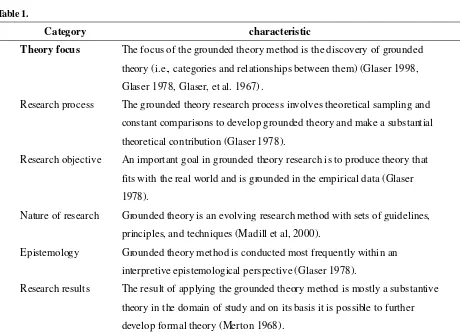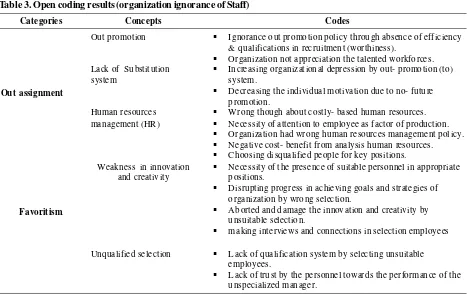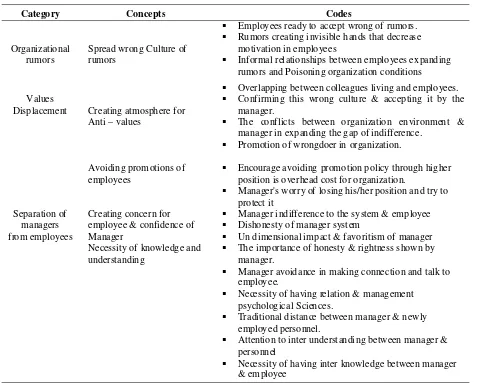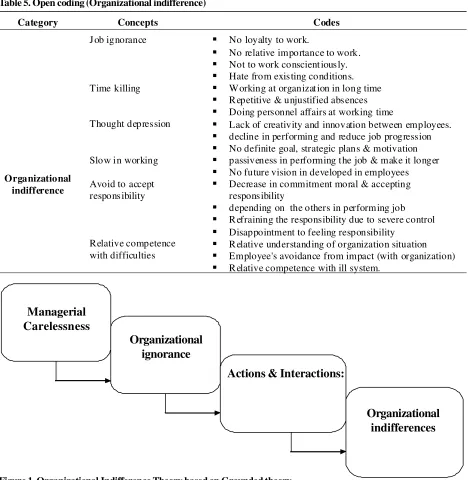The Use of Grounded Theory to discover organizational indifferences
in University of Brawijaya
Mohmad Tawfiq Abusharbeh
Doctorate Program of Accounting, Faculty of Economics and business University of Brawijaya Malang
Abstract: This paper uses of grounded theory approach as away of handling problematic of employees behavior in organization work, Managerial carelessness is the central phenomenon expressed a sets of actions and interactions that polluting organizational atmosphere. On the other hand may be its job unhealthiness, that leads employees tried to avoid or not accepted responsibility inside their organization work. This approach is illustrated in the context of organization research based on two cases of grounded theory analysis (a) study of face to face interaction in a university between employees. (b) Shape organiza-tional indifferences. This paper investigated with the main conditions that cause managerial carelessness in University of Brawijaya and make employees ready to leave organization. The paper concluded some propositions that discovered organizational indifferences by using Grounded theory.
Keywords: grounded theory, organization indifferences, and managerial carelessness
Abstrak: Penelitian ini menggunakan teori pendekatan grounded seberapa jauh penanganan masalah perilaku karyawan dalam bekerja organisasi. Kecerobohan Manajerial adalah fenomena sentral menyatakan tindakan dan interaksi yang mencemari atmosfer organisasi. Di sisi lain mungkin tugasnya kurang sehat, itu mengarah kepada karyawan yang mencoba untuk menghindari tanggung jawab yang diterima dalam pekerjaan organisasi mereka. Pendekatan ini diilustrasikan dalam konteks penelitian organisasi didasarkan pada dua kasus analisis grounded theory (a) studi interaksi tatap muka di sebuah universitas antara karyawan. (b) Bentuk indiffer-ences organisasi. Penelitian ini diselidiki dengan kondisi utama yang menyebabkan kecerobohan manajerial di Universitas Brawijaya dan membuat karyawan siap untuk meninggalkan organisasi. Makalah ini menyimpulkan beberapa proposisi yang ditemukan indifferences organisasi dengan menggunakan teori Beralas.
Kata Kunci: teori beralas, indifferences organisasi, dan kecerobohan manajerial
Alamat Korespondensi:
Mohmad Tawfiq Abusharbeh, Doctorate Program of Ac-counting, Faculty of Economics and business University of Brawijaya Malang, E-mail: [email protected] The policy of republic of Indonesia organizations is to linkage between political administration and the Indonesian societies. The performance of each will affect the legitimacy of political system. Despite population size of Indonesian that arrived at end of year 2011 over 238 Million people, and of 2010, an estimated 13.3% of the population was living below poverty line, the unemployment rate was 7.1% and
the job, have also outstanding roles in this gap and causes the employees indifferences will decrease their motivation to work, due to dissatisfaction from limited salaries and that giving shape of indifferences in the organizational level, hence this silences behavior expand the lack of understanding between the staff and its management. so that study attempt to explore and investigate this phenomenon in case of university of Barwijaya using grounded theory strategy, and that giving up managers in organization early alarms and discover this phenomenon causes and eliminate them. Hint, in this study, the researcher will attempt to create the organizational indifference literature based on conceptual theoretical framework. The objective of this research, the first of its kind, is to discover a new theory on organizational difference based on grounded theory and will not give final solution to managerial carelessness in environment of that educational university, in other words this study attempts to answer what is the theory of organization indifference in Barawjayia University-Malang?
Theoretical background of organizational
indifference:
Organization is the social phenomenon that required to investigated continuously with its management changes and its employees behavior, the phrase ”social phenomenon” indicates to all behavior which influences or is influenced by organisms sufficiently alive to respond to one another, and the objective nature of social life, study of groups, and group life, environmental, and ecological study (Markey, 1925).
Organization needs coordination and interaction models tied the actions and activities of individuals inside their works and to keep control on the organization objectives achievement, as (Robbins and Judge, 2008) organization behavior is considered to have two sides:
• Human side: which includes all people different activities and capacities in organization such mangers, labors, workers, accountants, employ-ees etc…..
• Material side: that included al elements such documents, raw materials, equipment machines, and all relevant information of organization.
Grounded theory method (GTM) in scientific
research:
The grounded theory method originates from sociology back in the 1960s and has since been further developed and applied in a variety of disciplines, including information systems research. At the focus of scholarly attention in a grounded theory study is the ’discovery’ or generation of ’grounded theory’ (Glaser et al. 1967). Prior research in sociology and related fields had focused more on deductive reasoning, deriving hypotheses from a priori theory and testing these hypotheses in empirical settings. Out of this well established research tradition, the grounded theory method was invented in order to achieve a shift of scholarly focus from theory testing to theory generation and discovery. The assumption was that there is a lot of experience and data ’out there’ in the empirical world to be discovered and explored and that researchers needed advice in forms of a research method in order to exploit the existing opportunities to generate new insights from real-world observations (Glaser 1978).
The main attention in a grounded theory study is given to the process of discovering concepts and categories, depicting the core categories and the relationships between them. The end result is usually a substantive theoretical contribution to the domain of study. In this section the study present the characteristics of GTM in discovering and formulating theory as follows table 1.
Theoretical background of research:
indifference on evaluate justice, they believed individual may be prepared himself to indifferences toward fairness of rewards. They argued people that have strong ideology working with hard work if they expected more rewards on salary. While Gartrell & Paille (1997) believed the responsibility for reducing rewards and motivation in organization works would probably cause indifference phenomena, they argued that personal responsibility would eliminate the comparison between reward and arbitration.
Julibert, (2008) explored the perceptions and attitudes of employees towards information sharing as well as the possible reasons behind these attitudes in the specific organizational context of the European Central Bank (ECB). She obtained in interviews with seven employees were analyzed using the grounded theory technique of constant comparative analysis. Categories, their sub-categories, attributes and dimen-sions were used to group data about related concepts and these groupings, and the emerging relations between categories, were linked to theoretical ques-tions regarding the percepques-tions and attitudes of
information sharing amongst ECB employees. Her results revealed employees interviewed acknow-ledged the advantages of information sharing and expressed the need for greater access to information as well as more open communication with colleagues. The participants’ perceptions of the organizational support to information sharing and their possible influence on employees’ attitudes to share with colleagues also emerged.
Tabaeian, (2001), believed that the concept of indifference in an organization describes the behavior of someone who carries out the organization’s activities without using her/his talent or creativity. Naturally such an obedience which is far from interest might seem to help maintain the organizational discipline, but will not encourage the employees to put more efforts, accept responsibilities and show some creativity. While Rezaeian (1999), showed Indifference in organization happens when one loses hope to accomplish his/her goals and tries to pull away from source of his/her disappointment, and felt no hope for improvement and motivations. A manager
Category characteristic
Theory focus The focus of the grounded theory method is the discovery of grounded
theory (i.e., categories and relationships between them) (Glaser 1998,
Glaser 1978, Glaser, et al. 1967).
Research process The grounded theory research process involves theoretical sampling and
constant comparisons to develop grounded theory and make a substantial
theoretical contribution (Glaser 1978).
Research objective An important goal in grounded theory research is to produce theory that
fits with the real world and is grounded in the empirical data (Glaser
1978).
Nature of research Grounded theory is an evolving research method with sets of guidelines,
principles, and techniques (Madill et al, 2000).
Epistemology Grounded theory met hod is conducted most frequently within an
interpretive epistemological perspective (Glaser 1978).
Research results The result of applying the grounded theory method is mostly a substantive
theory in the domain of study and on its basis it is possible to further
develop formal theory (Merton 1968).
should keep in mind that wrangling, coming up with reasons, a return to childhood, becoming accustomed and indifference are all the result of inability and failure which can point to existence of problems.
Research methodology:
This study is interpretive approach, and its philosophy foundation based on phenomenology. This study assumed that access to social reality through social constructs like: language, conscious experiences or may be sharing ideas. In other words reality is affected by human mental behaviors, trying to understand phenomenon through interpretation the information that obtained from people (Steinbock, 1995).
This is possibly happened as consequence of perceptions regarding the method which may stem partly from the language of the paradigm, open coding, axial coding, and verification procedures in grounded theory, which has connotations of positivist practices. Such attempts to structure, order and interpret data are commonly seen to defile the canons of pure qualitative or more precisely, phenomenological research where the primacy of the subjective experience of the participant takes precedence over the interpretation of the researcher (Goulding, 1998). This interpretive paradigm of qualitative study rely on constructivist approach that valid reality is subjective through actual sense experiences and constructed by researcher and respondents (Glasersfeld, 1995). The research design as understanding ontological, epistemological, and methodological concepts are suggested by Creswell (1998), in the first stage of this study make validity and reliability through data collecting and analysis, then explaining theory are on the other stages. The researched organization is University of Barwijaya-Malang. Data sources obtained from total number of official employees from Rector Building of university; the study selected 10 interviewees to confirm the subject accuracy.
This paper will focus on creating a conditional relationship guide, a method for discovering those patterns that contextualize a central phenomenon and the relationships among the categories from which those patterns are constructed in coding matrix (Strauss & Corbin, 1998).
Glaser & Strauss (1967), used grounded theory in three stages in analysis organizational research as following: (A) open coding (first stage) (B) axial coding (second stage) (C) selective coding (third stage) which this study uses in discovering organizational indifferences between employees in university of Barwijaya.
Results and concluding remarks:
First stage (opening coding):
According to Glaser & Strauss (1967) this stage has done by labeling and continuous notice events and analysis the process through which the concept acknowledged, and coding and that happened by collecting notes and concepts from environment of employees that working: after finished opening coding the researcher divided this stage into two primary and secondary coding: the first note events by researcher and that summarized in table 2.
The secondary open coding interprets the main ignorance’s of organization toward employees, which would probably lead further more indifference between employees in organization work and that summarize in table 3.
Table 3: concerned with organization environment and interactions among mangers and employees, which probably lead to poisoning organization atmosphere through rumors, anti - values and isolation case between top management and lower management, which resulted indifference among employees in organization.
Table 4 explained the concepts that formulated organizational indifferences among employees such time killing, thought depression, avoiding accepting responsibility that causes employees carelessness and leaving their works.
Second stage (Axial coding):
the study can derived the following theoretical conceptual framework of organization indifferences based on grounded theory:
Third stage (Selective Coding):
Selective coding is a theoretical stage which connected axial coding with its categories and concepts in order to create image, as Glaser (1998), he said from this stage the researcher can result auditing ideas and cases to perform numerical research.
Explanation Organizational Indifference
phe-nomenon
Organization activities included groups of human, technical, structural, cultural and other environment elements that are interacting together to achieve the main organization objectives, take into consideration the employees interests and needs, despite those individuals motivationally are different, but management role in balancing and effective use of individual’s potential will be crucial, because organization’s personnel are the most important part
Table 2. Open coding (Organizational Carelessness)
Categories Concepts Codes
Managerial carelessness
Grounded of recruiting workforce program
Barwijaya is interesting to new recruiting workforce. Encourage the recruitment policy in the organization. Lack of interesting of employees in doing job.
Carelessness toward organization Employees not accomplish the objectives and strategies in organization.
Declined in
motivation due to Fixed salaries
Unwillingness in handling activities for receiving a fixed salary.
The salaries rose upon the type of activities. Salaries increased upon experiences. Propagation of
yea-sir culture
Training a workforce just to say "yes – sir".
Table 3. Open coding results (organization ignorance of Staff)
Categories Concepts Codes
Out assignment
Out promotion Ignorance out promotion policy through absence of efficiency & qualifications in recruitment (worthiness).
Organization not appreciation the talented workforces. Lack of Substitution
system
Increasing organizational depression by ou t- promotion (to) system.
Decreasing the individual motivation du e to no- future promotion.
Human resources management (HR)
Wrong though about costly- based human resources. Necessity of attention to employee as factor of production. Organization had wrong human resources management policy. Negative cost- benefit from analysis human resources.
Favoritism
Weakness in innovation and creativity
C hoosing disqualified people for key positions.
Necessity of the presence of suitable personnel in appropriate position s.
Disrupting progress in achieving goals and strategies of organization by wro ng selection.
Aborted and damage the innovation and creativity by unsuitable selection.
making interviews and connections in selection employees
Unqualified selection Lack of qualification system by selecting unsuitable employees.
of it and ignoring their wills and fulfilling their requirement, will have conflict of interests between personnel and organization. The organizational indifference explains the reasons (why) of behavior and carelessness. The question is this: why such a problem arises? What causes the indifference in employees?
Organizational indifference theory expresses that: due to dominant management carelessness on organization (university), some elements such as; weak assessing system of organizational performan-ce, salaries limited, no interest of organization toward its employees will reveal an ignorance feeling to individual (employees), and conditions such as: lack of creativity, out- promotion or assigning unqualified individuals and less attention to job improvement of personnel will confirm this feeling.
Table 4. Interactions among employees: (Polluting organization atmosphere)
Category Concepts Codes
Organizational rumors
Spread wrong Culture of rumors
Employees ready to accept wrong of rumors. Rumors creating invisible hands that decrease
motivation in employees
Informal relationships between employees expanding rumors and Poisoning organization conditions
Values
Displacement Creating atmosphere for Anti – values
Overlapping between colleagues living and employees. Confirming this wrong culture & accepting it by the
manager.
The conflicts between organization environment & manager in expanding the gap of indifference.
Promotion of wrongdoer in organization.
Separation of managers from employees
Avoiding promotions of employees
Encourage avoiding promotion policy through higher position is overhead cost for organization.
Manager's worry of losing his/her position and try to protect it
Creating concern for employee & confidence of Manager
Manager indifference to the system & employee Dishonesty of manager system
Un dimensional impact & favoritism of manager Necessity of knowledge and
understanding
The importance of honesty & rightness shown by manager.
Manager avoidance in making connection and talk to employee.
Necessity of having relation & management psychological Sciences.
Traditional distance bet ween manager & newly employed personnel.
Attention to inter understanding between manager & personnel
Necessity of having inter knowledge between manager & employee
This organizational ignorance to personnel is accompanied by unhealthy job carelessness, culture policy and financial conditions crisis, which will end to polluting organizational atmosphere (actions and interactions). Of these conditions are; spread of culture, internal distrust, separation of management from employees and their managers, this will lead managerial careless and employees seeking for other job. The result of this organization atmosphere polluting, is called organizational indifference phenomenon.
Concluding remarks of research:
Table 5. Open coding (Organizational indifference)
Category Concepts Codes
Organizational indifference
Job ignorance No loyalty to work.
No relative importance to work.
Not to work conscient iously.
Hate from existing conditions. Time killing Working at organizat ion in long time
R epetitive & unjustified absences
Doing personnel affairs at working time
Thought depression Lack of creativity and innovation between employees.
decline in performing and reduce job progression
Slow in working
No definite goal, strategic plans & motivation
passiveness in performing the job & make it longer
No future vision in developed in employees Avoid to accept
responsibility
Decrease in commitment moral & accepting responsibility
depending on the others in performing job
R efraining the responsibility due to severe control
Disappointment to feeling responsibility Relative competence
with difficulties
R elative understanding of organization situation
Employee's avoidance from impact (with organization)
R elative competence with ill system.
Managerial
Carelessness
Organizational
ignorance
Actions & Interactions:
Organizational
indifferences
order to collect data and arranged inputs of organization indifference theory. The results of this research is given companions and the text have been studied by opinions and their views been applied. Since the constructing method in this research has been ”interview”, the derived categories and concepts have been shown to interviewees to confirm the subject accuracy. The technique for verification of theory was member check related to the central outcome of grounded theory research.
Figure 1. Organizational Indifference Theory based on Grounded theory
Research hypotheses based on grounded
theory:
In this study, on the bases of research story and model of organizational indifference theory, four propositions are proposed:
culture which cause organizational ignorance to employee.
P2 : Organizational ignorance to employee in-cludes: out assignment and Favoritism pollut-ing organization atmosphere or condition. P3 : Organizational rumor, value displacement,
in-ters- organization distrust, separation between manager and personnel and employee orga-nizational isolation is of those international actions and reactions which cause organiza-tional indifference.
P4 : Organizational indifference is a result of or-ganization polluting atmosphere. In fact, ig-noring and time killing, thought depression and disability, and avoiding carrying responsibili-ties cause employees carelessness and think-ing to find another job.
REFERENCES
Creswell, J.W. 1998. ”Qualitative Inquiry and Research Design; Choosing Among Five Traditions”. Sage Publications.
Central Intelligence Agency. Republic of Indonesia. 2011.
https://www.cia.gov/library/publications/the-world-factbook/geos/id.html
Glasersfeld, E. 1995. Radical constructivism: A way of knowing and learning.
Gartrell, C.D., Paille, B.E. 1997. ”Wage guts and the fair-ness of pay in a worker-oriented plywood coopera-tive”. Social Psychology QAuarterly, 60:103–17. Fard, H., and Eslami, A. 2010. ”Discovering Theory of
Or-ganizational Indifference: A Grounded Theory Strat-egy”. European Journal of Scientific Research. Vol.40 No. pp.450-460
Goulding, C. 1998. ”Grounded theory: the missing metho-dology on the interpretive agenda”. An International Journal Qualitative Market Research. Vol 1. No1. 50–57.
Glaser, B.G. 1998. Doing Grounded Theory: Issues and Dis-cussions. Mill Valley, USA.
Glaser, B.G. 1978. Theoretical Sensitivity. Mill Valley, USA. Glaser B.G., Strauss, A. 1967. ”Discovery of Grounded Theory”. Strategies for Qualitative Research. Socio-logy Press.
Glaser, B.G. 1998. ”Doing Grounded Theory - Issues and Discussions”. Sociology Press.
Julibert, S. 2008. ”Employee attitudes to information shar-ing: a case study at the European Central Bank”. Records Management Journal. Vol. 18 No 3. pp.194 – 204.
Madill, A., Jordan, A., and Shirley, C. 2000. Objectivity and reliability in qualitative analysis: Realist, contextualist and radical constructionist epistemologies. British Journal of Psychology, 91(1), 1–20.
Markey, J. 1925. ”A Redefinition of Social Phenomena: Giv-ing A Basis for Comparative Sociology.” American Journal of Sociology Vol. 31. 733-743
Merton, R.K. 1968. Social Theory and Social Structure. The Free Press, New York, USA.
Rezaian, A. 1999. ”Organizational behavior management: concepts, controversies & applications”. Tehran: elm o adab. (Persian).
Robbins, S., & Judge, T. 2008. Essentials of Organiza-tional Behavior. 9th ed. New Jersey: Pearson/Prentice Hall.
Steinbock, A. J. 1995. Home and Beyond, Generative Phe-nomenology after Husserl. Northwestern University Studies in Phenomenology and Existential Philoso-phy



